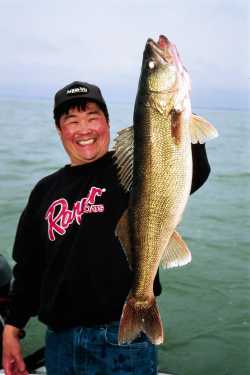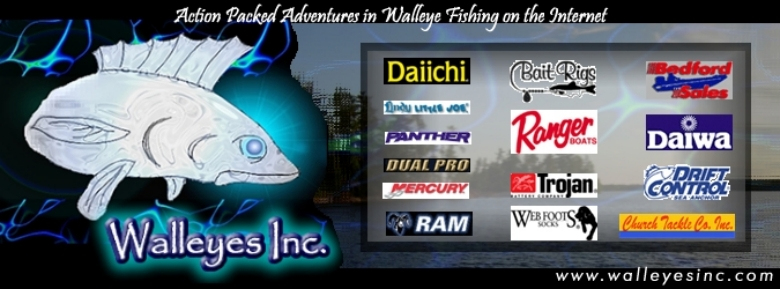|
Fall is big fish time, and while others resort to big jigs
to catch them, Northwoods guide Greg Bohn sticks with the
same tactic he uses all spring and summer long. There’s a
reason he’s called “Mr. Slip Bobber ™.” “People often believe
that there are more effective presentations for fall walleyes.
There’s not,” said Bohn, who’s been guiding clients to big
fish in the Minocqua, Wis., area for 30 years. “One of the
best ways to catch a trophy walleye is to suspend a jumbo
leech, nightcrawler or chub just off the bottom where they
can readily see it.” The arrival of shorter days and cooler
nights in autumn sends water temperatures downward. Walleyes
respond by moving from shallow areas when weeds begin to die
to deeper water. They don’t make the transition overnight.
They move deeper in increments. As they do, they start to
appear in places where slip bobbers work best — sand bars,
rocks and mid-lake humps, he said. They often suspend to find
temperatures in their comfort zone. If you use a jig, the
bait will be below them. “I sometimes have to fish 4 to 5
feet off the bottom. That’s when a slip bobber is killer,”
Bohn said. Some anglers think walleyes are too deep to use
slip bobbers to reach them in fall. Not Bohn. “I’m sometimes
fishing 30- to 40-feet down. It’s not a problem.” Slip-bobbering
is more than just a bobber stop, float, split shot and hook.
A split shot crimped on the line will damage it, and weak
line won’t hold a wall-hanger. Remember, we’re talking big
fish here. Three pounds is an average fish. “They go all the
way up to 10 pounds plus,” Bohn said. Start with 8 to 10 pound
Stren Magna Thin for a main line and slide on a thread-style
bobber stop. They snug tight enough to maintain the preferred
depth setting, yet they allow depth adjustments when needed.
They don’t nick the line like other styles can do. Trim the
tag ends to about 1/2 inches long so you can tighten up the
knot. Use a stop made in a bright color you can see.
 |
You’ll want to be certain the float slides up to meet
the stop each time you cast. That’s the only way you can
know the bait is where you want it to be. Thread on a
red glass bead and a Thill Center Slider or a Mille Lacs
Center Slider, both made by Lindy Legendary Fishing Tackle.
Tie on a barrel swivel and add a 2-foot leader of line
lighter than the main. If you get snagged, you can break
off the leader without losing the whole rig. The business
end should be a 1/16 or 1/8 ounce Max Gap jig or a Bleeding
Bait red hook with a red glass bead above it. Avoid using
bigger jigs to fish deep. Better to use small jigs that
are easily inhaled and add one thirty-second, one-sixteenth
or one-eighth rubber core sinker on the leader to balance
the rig. Set it so the float rides mid-way in the water.
Done right the slip bobber will signal even the lightest
of bites. Rule-of-thumb thinking is that chubs are the
best live bait for cold water. But, jumbo leeches and
nightcrawlers work well into October. |
 |
Have all three baits on the boat and offer walleyes
a variety. Bohn always has a jumbo leech on at least one
rig. “It’s often the big leech or whole nightcrawler that
attracts the biggest fish.” Panfish and smaller game fish
aren’t usually a bother when using nightcrawlers at this
time of year. If a six pound smallmouth is lurking near
the trophy spots you’re targeting, it gets caught, Bohn
said. Live bait should be fresh looking and lively. Slip
bobbers give walleyes plenty of time to decide whether
they want to eat it or not. Unattractive bait will turn
them away. Check prime big-walleye locations with your
sonar. Use your electric trolling motor to move the boat
over the spot as you look for walleyes on the screen.
Ask yourself...are they in sand or boulders? Are they
suspended? Don’t worry if you don’t see any walleyes at
all. They’re sometimes so tight to the bottom or hiding
amidst the boulders they don’t show up at all. Try spots
that experience says should hold fish. Next, drop a marker
buoy on the downwind side of the structure. Take time
to set your bobber 1 to 3 feet off the bottom at the top
of the structure using an ice-fishing clip-on weight.
Move upwind with the electric motor well off the structure,
and throw your anchors. |
Use heavy ones so you don’t blow over the spot and drag the
anchors with you. That can spook the fish. Let out enough
rope to put the boat over the deepest edge. Bohn puts one
slip bobber off the stern of the boat in the sonar cone. He
can watch to see if a fish comes by for a look. It’s often
the first bait to be hit by roaming walleyes. Cast the others
over the top of the structure between the boat and the marker
buoy. Let the wind drift them over the structure. Windy days
are best because the waves will impart a lot of action. Then
the hard part begins – the wait. “A lot of those suspended
walleyes slide over the top bars and humps throughout the
day. Timing is everything. It’s not uncommon to sit for a
couple of hours and not have a bite, and then have two bobbers
go down at the same time and both be 7-pound walleyes. In
any body of water, there are only so many good trophy spots.
Don’t be afraid to move if one spot doesn’t produce. “Oftentimes,
I’ll check a spot and there’ll be nothing. I come back in
a couple of hours and they are all over the place,” Bohn said.
When a strike comes, give the walleye time to eat the bait.
You’re using big morsels, after all. Wait 15 seconds or so.
Don’t set the hook too hard. A trophy walleye can break the
line if you do. Instead, snap the rod back to drive the point
home. If you catch one trophy, are others still lurking on
the same spot? “Probably yes,” Bohn said. Use slip-bobbers
or they just might give you the slip.
|

